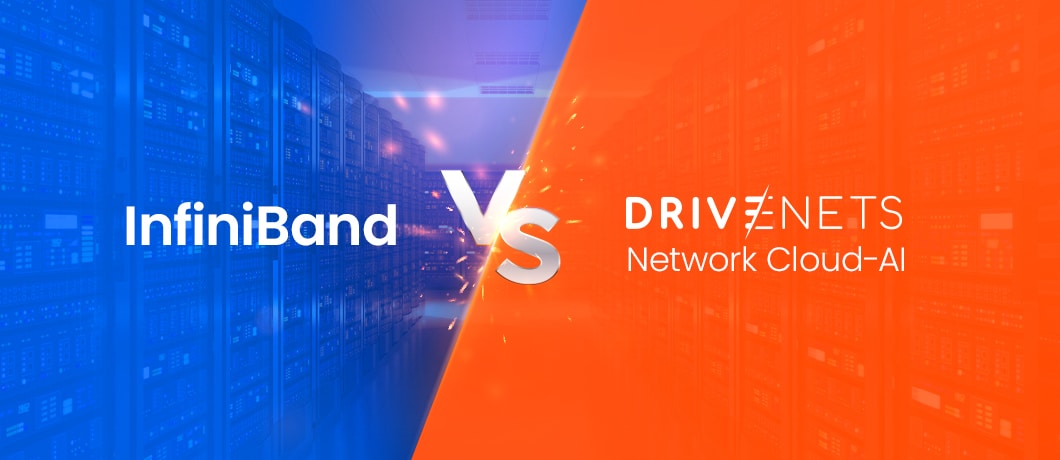|
Getting your Trinity Audio player ready...
|
InfiniBand vs. Ethernet: A brief overview
To align with the ever-growing demands of data centers, selecting a networking technology for hyperscale data centers is more crucial than ever. For data transmission, InfiniBand and Ethernet, compete for supremacy. As networking technologies, InfiniBand and Ethernet have their own characteristics and differences, developing and evolving in their different application fields, and becoming indispensable Technologies for networking. InfiniBand and Ethernet represent divergent network communication technologies, marked by differences in design objectives, transmission rates and latency, reliability and scalability, cost and maintenance, and application areas. InfiniBand and Ethernet continue to embrace ongoing technological innovation and enhancements.
What is InfiniBand?
InfiniBand is a high-speed networking technology primarily designed for high-performance computing (HPC) environments. It offers extremely low latency and high bandwidth, making it suitable for applications that demand predictable and lossless fabric. Though InfiniBand is a powerful network technology, it is a practically proprietary protocol that comes with a hefty price tag and vendor lock-in on the networking and GPU levels. As a result, the industry is looking for alternative solutions that are more cost-effective and free of vendor lock-in.
What is Ethernet?
Ethernet, on the other hand, is a widely adopted networking technology that has evolved over the years to meet the growing demands of data centers. It is the de facto networking standard today, with over 600M ports shipped annually. It offers flexibility, scalability and ease of use, making it a popular choice for various applications, including AI networking. With advancements such as data center bridging (DCB) for use with clustering and storage area networks, Ethernet has improved its performance characteristics, including reduced latency and enhanced quality of service (QoS).
AI networking: How do you compare InfiniBand and Ethernet
Until now, AI networks have been based on either Ethernet-based or semi-proprietary solutions. Traditional Ethernet leaf-and-spine architecture is not designed to support high-performance AI workloads at scale. Semi-proprietary solutions such as Nvidia’s InfiniBand do not support network interoperability and provide little flexibility for hyperscalers looking to avoid vendor lock-in.
Bandwidth and latency
InfiniBand excels in terms of raw bandwidth, with its latest generations offering speeds up to 200 Gbps and beyond. This high throughput is beneficial for AI workloads that involve massive data transfers. However, Ethernet has also made significant strides, and modern Ethernet technologies such as 800 Gbps interfaces, which InfiniBand will not support for two more years, provide substantial bandwidth meeting the requirements of most AI applications. While InfiniBand traditionally offered lower latency, advancements in Ethernet technologies have significantly narrowed the gap, making it a viable option for low-latency AI workloads.
Scalability and flexibility
Ethernet’s widespread adoption and compatibility make it highly scalable and flexible. It is compatible with existing data center infrastructure and supports a broad range of devices, making it easier to integrate into diverse network environments. In contrast, InfiniBand may require specific hardware and software configurations, limiting its scalability and interoperability. Ethernet’s compatibility and cost advantages over time give it an edge in traditional infrastructure clusters.
Security and management
InfiniBand lacks Ethernet’s breadth of security and management features, which have been built by Ethernet vendors over multiple decades. Ethernet’s long-standing presence in enterprise and service networks has enabled the development of robust security protocols and comprehensive management capabilities. This makes Ethernet a more favorable choice for organizations that prioritize security and efficient network management in their AI deployments.
Cost-effectiveness and industry adoption
Ethernet’s popularity and mass production have made it more cost-effective compared to InfiniBand. The widespread use of Ethernet components and equipment results in lower costs for deployment and maintenance, making it an attractive choice for organizations with budget constraints. Furthermore, IDC research suggests that Ethernet remains the protocol of choice for the vast majority of AI workloads, estimating that 90% of AI workloads will run on Ethernet in 2025. While InfiniBand may have some niche use cases in HPC-like workloads, Ethernet is well-positioned for both external connectivity and internal compute networks, for a variety of applications and AI workload types that are connected online.
How is DriveNets Network Cloud-AI the best of InfiniBand and Ethernet?
DriveNets Network Cloud-AI offers the best of both worlds. It supports up to 30% improvement in job completion time (JCT) of large-scale AI workloads compared to other Ethernet solutions, substantially improving resource utilization. It also supports standard Ethernet, which allows for vendor interoperability and choice. DriveNets Network Cloud-AI is an innovative artificial intelligence networking solution designed to maximize the utilization of AI infrastructures and improve the performance of large-scale AI workloads. Built on DriveNets Network Cloud, which is deployed in the world’s largest networks, DriveNets Network Cloud-AI has been validated by leading hyperscalers in recent trials as the most cost-effective Ethernet solution for AI networking. By utilizing Ethernet, DriveNets offers a cost-effective and scalable solution that integrates seamlessly with existing network infrastructure both for internal compute and external connectivity.
The solution offers lossless connectivity, low latency and low jitter by collapsing multi-tier Clos architecture (ToR/leaf-spine/super-spine) into a flat, single-switch architecture with inter-rack connectivity running on a scheduled fabric (and not an Ethernet-based multi-hop interconnect).
Effectively leveraging ethernet for AI networking with scheduled fabric
InfiniBand and Ethernet are both powerful networking technologies with unique strengths in different contexts. While InfiniBand traditionally excelled in high-performance computing environments, Ethernet has evolved to meet the demands of modern data centers and AI applications. The DriveNets Network Cloud-AI solution demonstrates how Ethernet can be leveraged effectively for AI networking with scheduled fabric. DriveNets Network Cloud-AI presents a unique and innovative architecture that offers the high performance and scale of a fabric interconnect solution with the cost-effectiveness of an open, disaggregated cloud solution.

Key Takeaways
- InfiniBand’s Limitations in Scalability and Cost: While InfiniBand has traditionally been favored for high-performance computing due to its low latency and high throughput, it presents challenges in AI networking. These include high costs, vendor lock-in (primarily with NVIDIA), and complexity in scaling across large, distributed AI clusters. Such limitations make it less suitable for the evolving demands of AI workloads.
- Ethernet’s Evolution to Meet AI Demands: Ethernet has matured to address the needs of AI networking. Advancements like DriveNets’ scheduled fabric technology enable Ethernet to provide predictable, lossless, and low-latency performance, matching or surpassing InfiniBand in certain scenarios. This evolution makes Ethernet a viable and cost-effective alternative for AI infrastructures.
- DriveNets Network Cloud-AI’s Performance Advantages: The DriveNets Network Cloud-AI solution demonstrates significant performance improvements. By utilizing a scheduled fabric architecture, it achieves up to 30% better job completion times (JCT) compared to other Ethernet solutions, enhancing resource utilization and efficiency in AI workloads.
- Open and Vendor-Agnostic Architecture: Unlike InfiniBand, which often ties users to specific vendors, Ethernet-based solutions like DriveNets’ offer an open architecture. This openness ensures interoperability, allowing organizations to integrate various hardware components without being confined to a single vendor ecosystem.
- Simplified Operations and Reduced Complexity: Ethernet’s widespread adoption and familiarity among IT professionals simplify deployment and management. DriveNets’ solution further reduces complexity by collapsing traditional network layers into a flat, single-switch architecture, streamlining operations and minimizing the need for extensive fine-tuning.
Frequently Asked Questions
- Why is Ethernet often considered a cost-effective solution for ai workload networking compared to InfiniBand?
While InfiniBand has traditionally been favored for high-performance computing due to its low latency and high throughput, it presents challenges in AI networking. These include high costs, vendor lock-in (primarily with NVIDIA), and complexity in scaling across large, distributed AI clusters. Ethernet, on the other hand, has matured to address the needs of AI networking. Advancements like DriveNets’ scheduled fabric technology enable Ethernet to provide predictable, lossless, and low-latency performance, matching or surpassing InfiniBand in certain scenarios. This evolution makes Ethernet a viable and cost-effective alternative for AI infrastructures. - How does DriveNets’ Network Cloud-AI enhance Ethernet’s capabilities for AI workloads?
DriveNets’ Network Cloud-AI utilizes a scheduled fabric architecture to transform standard Ethernet into a high-performance, lossless network suitable for AI applications. This architecture collapses traditional network layers into a flat, single-switch design, reducing complexity and latency. It supports up to 32,000 GPUs with 800Gbps connections in a single cluster, achieving up to 30% better job completion times (JCT) compared to other Ethernet solutions. Additionally, its open and vendor-agnostic design ensures interoperability, allowing organizations to integrate various hardware components without being confined to a single vendor ecosystem. - What are the scalability advantages of Ethernet over InfiniBand for AI data centers?
Ethernet offers greater scalability for large AI clusters compared to InfiniBand. InfiniBand requires specialized configurations and often results in network bottlenecks or complexity at scale. In contrast, Ethernet—especially when implemented with DriveNets’ scheduled fabric—supports flat, large-scale architectures with thousands of GPUs, making it easier and more cost-effective to expand AI infrastructure without sacrificing performance or simplicity.
Related content for AI networking architecture
DriveNets AI Networking Solution
Latest Resources on AI Networking: Videos, White Papers, etc
Recent AI Networking blog posts from DriveNets AI networking infrastructure experts
DOWNLOAD BROCHURE
Utilizing Distributed Disaggregated Chassis (DDC) for Back-End AI Networking Fabric




